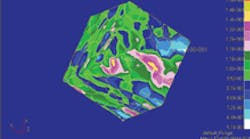Finite element analysis has become a standard tool for ensuring the structural integrity of components such as turbine blades and diesel engines. So why do auto companies pay huge royalties and the largest U.S. companies spend about $30 billion a year on warranties? Because conventional macroscopic FEA doesn’t really account for part material processing variability, says Loren Nasser, CEO of Vextec Corp., Brentwood, Tenn. “For instance, say you have produced 10,000 parts. Common sense tells you that in the real world, the parts will never be processed exactly identically.”
Until now, missing in traditional FEA was a way to factor in how the material itself reacts to stress forces and how reactions evolve and change over time, says Nasser. Vextec addresses this shortcoming with a managed service and software with a statistical basis called Virtual Life Management. It links to FE structural analysis packages such as Ansys, Nastran, or Abaqus and translates global stresses down to a metal’s grain level. This approach is necessary because seemingly identical components might have many different grain configurations, depending on how the metal is heated or cooled and on other factors.
Vextec started in 2000 and got funding from the Air Force Research Laboratory in Dayton, Ohio. Since then, the firm has assembled a library of how different kinds of metals under different processing techniques respond to stress as a function of cycles or time. “Once you have captured the nominal physics that defines a family of metals such as steel, aluminum, and stainless steel, it’s really just a matter of fine-tuning for the specific application and the processing that makes one manufacturer different from another,” says Nasser.
Setting up a simulation usually takes about 60 to 90 days. The company first determines the arrangement of a particular microstructure by carving out and slicing a sample taken from the component of interest. It then looks at the segments under a high-resolution scanning electron microscope to count grains and determine their layout, variation, and active failure mechanism. This data becomes part of the software’s statistical basis for building models with Monte Carlo and probabilistic approaches. Also accounted for are defects such as a contaminate in a casting — a part of real-world manufacturing — and environmental effects. For the computational setup, parameters include variables such as vibration, temperature, and operating pressure.
“Once we build the component simulation, the analysis takes only about 30 minutes on the computational cloud we have set up for Web access by our customers,” says Nasser. “Because stress at the grain level turns into energy, the model shows whether there is sufficient energy to initiate a crack in a grain and, if so, whether the crack is likely to grow to surrounding grains. Consider a turbine blade as an example. There might be a million grains in the component. To do an analysis, the software accounts for variability by modeling every one of the grains hundreds of billions of times.” In this manner Vextec predicts a realistic “spread” in component failure for an entire production lot of components.
Modeling at this refined level produces eerily accurate simulations, says Nasser. “Manufacturers can see how and when products will fail before one part is made. For example, a recent job involved modeling a titanium blade for a commuter jet. Real-world tests had already mimicked millions of takeoffs and landings by shaking the blade over and over. The software estimated when and where, within a quarter inch, the cracking of the three-foot-long blade actually started. Needless to say, these kinds of simulations can significantly slash development costs.”
Soon to come is the licensing of component simulators so OEMs can conduct their own engineering studies. This year, the company is building and releasing Virtual Twin product simulations so customers can interrogate items themselves. In addition, Vextec is about three years from providing the software as a commercial package so users can build their own component simulators. Also in the works is the modeling of composites. “The modeling analogy is similar to that of metals but instead of grains, there are ply angles, ply structures, and layers of ply material,” says Nasser.
Resources:
Vextex, www.vextec.com
Authored by Leslie Gordon
